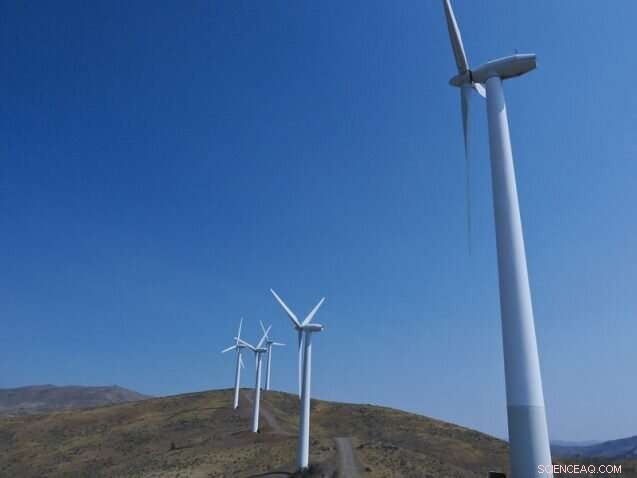
Turbine eoliche in Oregon. Credito:Bureau of Land Management
Non molto tempo fa, i critici delle fonti di energia rinnovabili hanno avuto ragione quando hanno affermato che l'energia eolica e solare costano di più ed erano meno affidabili dei combustibili fossili, principalmente perché dipendono dal vento che soffia e dal sole che splende.
Ma questo sta cambiando. La costante progressione dei risultati scientifici sta rendendo l'eolico e il solare tanto efficienti in termini di costi da produrre quanto i combustibili fossili e sempre più competitivi nello stoccaggio di energia.
"I miti sull'energia rinnovabile si basano su prezzi e prestazioni che sono tipicamente obsoleti", ha affermato Bruce Usher, professore di pratica professionale alla Columbia Business School, dove insegna sull'intersezione di questioni finanziarie, sociali e ambientali.
I progressi hanno migliorato le prestazioni e ridotto i costi, ha affermato Steven Cohen, ex direttore esecutivo di lunga data dell'Earth Institute presso la Columbia University e ora vice preside senior della School of Professional Studies dell'Università.
"Proprio come abbiamo visto con i computer, più tempo gli ingegneri trascorrono su questi problemi, migliore diventa la tecnologia", ha affermato.
Nel frattempo, il mito rimane.
Rinnovabili e condizioni meteorologiche estreme
Nonostante le affermazioni contrarie, le energie rinnovabili non sono meno affidabili di altre fonti di energia durante gli eventi meteorologici estremi.
In Texas, che è l'unico stato con una propria rete elettrica, il governatore Greg Abbott ha falsamente accusato l'energia eolica e solare del fallimento della rete energetica dello stato durante lo scorso inverno durante forti tempeste che hanno visto l'interruzione della produzione di energia e il congelamento dei gasdotti. L'ex segretario all'Energia Rick Perry si è accumulato, sostenendo che l'incidente ha esposto il pericolo di fare affidamento sulle energie rinnovabili.
Uno studio federale ha effettivamente rilevato che le fonti rinnovabili hanno sovraperformato la produzione di combustibili fossili durante l'incidente, che è stato principalmente causato da guasti di apparecchiature non adeguatamente protette dalle temperature di congelamento, indipendentemente dalla fonte di energia. National Public Radio ha concluso che è stato un fallimento a livello di sistema per prepararsi al freddo estremo.
Cohen ha affermato che il caso in Texas è stato anche un fallimento della regolamentazione.
"A causa della natura deregolamentata del sistema elettrico del Texas, i mulini a vento che possono essere facilmente protetti dal freddo non erano protetti", ha affermato. "I mulini a vento nel nord Europa e negli Stati Uniti non hanno problemi a funzionare al freddo."
In California, altri critici delle energie rinnovabili hanno fatto affermazioni simili la scorsa estate durante i blackout legati alle ondate di caldo, anche dopo che uno studio statale ha scoperto che le cause principali erano condizioni meteorologiche estreme indotte dai cambiamenti climatici, risorse e processi di pianificazione inadeguati, insieme a pratiche di mercato, tutte non correlate a rinnovabili.
"In California il problema riguarda anche le vecchie apparecchiature di trasmissione, che provocano incendi boschivi e poi vengono danneggiate durante gli incendi", ha affermato Cohen.
Perhaps the common denominator among the energy failures caused by a frozen Texas and a blistering California is that neither state is prepared for the challenges presented by climate change.
Moving toward better storage and transmission
In California, the main issue wasn't a lack of power generation, but not enough investment in batteries to store wind and solar power.
Usher points to advancements in battery technology as what has made renewable energy more reliable.
"Wind and solar have always been reliable generators of power," Usher said, "when it's windy and sunny." It was the storage half of the equation that, in the past, made them less dependable.
"Wind and solar projects are increasingly being paired with energy storage—primarily in the form of batteries—making renewable sources more reliable by addressing the intermittency of wind and solar power generation," Usher said.
Along with more and better storage, both experts identified another key to increasing renewable energy production:moving the electricity from where it is generated to where it is needed. High-capacity transmission lines will help, Cohen said.
Funding the future of energy
Usher said that government tax incentives can play an important role in advancing battery technology and updating energy infrastructure, for example. But Cohen thinks the free market is the bigger engine here.
Most of the resources will come from energy utilities and consumers who will benefit from a more efficient and reliable energy system once renewables, microgrids and distributed generation of energy is combined with wind and solar farms, he said.
Cohen noted in a recent blog post that we're already seeing a surge in climate-friendly stocks and a declining interest in fossil fuel companies, which are losing ground to renewable energy firms in attracting new capital.
Nonetheless, neither expert predicts renewables taking the place of fossil fuels any time soon.
"I think the idea that there is some number or quick fix is delusional," Cohen said. "This is a transition that will take a generation to complete."
Usher adds that "Anyone who thinks renewable power isn't the future of energy isn't looking at the fundamental trends that are nearly certain to create strong tailwinds for the industry for the next 30 years:lower costs plus increasing demand from electric vehicles and demand to decarbonize. The energy transition from fossil fuels to renewables will almost certainly happen, but over 30 years, not overnight."